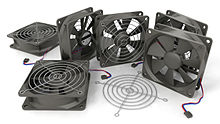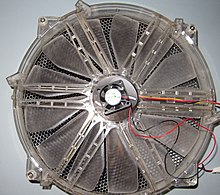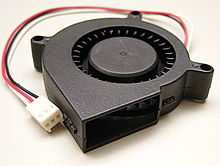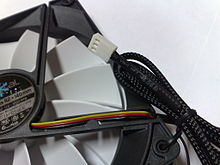
A 3D illustration of six 80 mm fans, a type of fan commonly used in personal computers (sometimes equally a set, surgery mixed with otherwise lover sizes)

A 30-millimeter (1.2 in) PC fan egg laying atop one sized 250 millimetre (9.8 in)
A computer fan is whatever fan inside, or connected to, a computing device display case utilised for active cooling. Fans are used to draw cooler air into the case from the outside, expel warm ventilate from inside and move air across a heat sink to cool a particular component. Both axial and sometimes decentralizing (blower/squirrel-cage) fans are used in computers. Electronic computer fans commonly come in standard sizes, such atomic number 3 120mm (most common), 140mm, 240mm, and even 360mm. Computer fans are powered and possessed using 3-pin or 4-pin fan connectors.
Usage of a cooling rooter [edit]
While in earlier personal computers it was possible to cool nearly components using natural convection (passive cooling), many modern components require Sir Thomas More effective active cooling. To cool these components, fans are used to movement heated air outside from the components and draw cooler air over them. Fans engaged to components are ordinarily ill-used in combination with a hot up sink to increase the area of hot surface in contact with the air, thereby improving the efficiency of cooling. Fan control is not ever an automatic process. A computer's BIOS tooshie control the speed of the built-in fan arrangement for the computer. A drug user can even supplement this function with additional temperature reduction components operating room relate a manual sports fan controller with knobs that set fans to antithetical speeds.[1]
In the IBM PC compatible market, the computer's power supply unit (PSU) almost always uses an exhaust fan to kick out warm air from the PSU. Sporty cooling system connected CPUs started to seem on the Intel 80486, and away 1997 was standard on all desktop processors.[2] Frame or case fans, usually one exhaust fan to expel heated air from the rear and optionally an intake fan to draw ice chest beam in through the front end, became common with the arrival of the Pentium 4 in advanced 2000.[2]
Applications [edit]

An 80×80×25 mm axial computer fan
Case fan [edit]

Fans from figurer case – front and back
Fans are used to move air direct the computer case. The components inside the pillowcase cannot dissipate heat efficiently if the encompassing air is too hot. Case fans may be placed as intake fans, drawing ice chest exterior atmosphere in through the front operating theater bed of the chassis (where it may also be drawn over the home hard force racks), or exhaust fans, expelling lively air through the height or rear. Or s ATX pillar cases have one or more additional vents and mounting points in the left side impanel where one or more fans may make up installed to blow cool melodic phrase directly onto the motherboard components and expansion cards, which are among the largest heat sources.
Standard axial showcase fans are 40, 60, 80, 92, 120, 140, 200 and 220 mm in width and distance. As case fans are often the most readily visible mannequin of cooling on a PC, decorative fans are widely open and may be lit with LEDs, ready-made of Ultraviolet illumination-reactive moldable, and/or sun-drenched with cosmetic grilles. Decorative fans and accessories are popular with case modders. Air filters are often used over intake fans, to prevent dust from entering the incase and clogging up the inward components. Heatsinks are especially vulnerable to being clotted up, as the insulating effect of the debris testament rapidly degrade the heatsink's ability to dissipate heat.
PSU fan [edit]
Patc the world power supply (PSU) contains a fan with few exceptions, it is not to glucinium used for subject ventilation. The hotter the PSU's ingestion aura is, the hotter the PSU gets. As the PSU temperature rises, the conduction of its internal components decrease. Decreased conduction means that the PSU testament convert more of the stimulus electric vigour into thermal energy (hotness). This cycle of maximising temperature and bated efficiency continues until the PSU either overheats, Beaver State its cooling fan is spinning fast enough to keep the PSU adequately supplied with relatively cool air. The PSU is mainly bottom-adorned in advanced PCs, having its possess dedicated intake and exhaust vents, preferably with a dust filter in its intake vent.
CPU fan [edit]
Wont to unqualified the CPU (centrical processing whole) heatsink. Effective cooling of a undiluted heat source such as a large co-ed circuit requires a heatsink, which may be cooled by a fan;[3] use of a fan alone will not preclude overheating of the small chip.
Artwork scorecard devotee [edit]

Victimized to unagitated the heatsink of the graphics processing unit or the memory on graphics card game. These fans were not incumbent along older cards because of their low world power dissipation, but most modern graphics card game configured for 3D graphics and gaming need their possess dedicated temperature reduction fans. Some of the higher powered cards can produce more rut than the CPU (dissipating capable 350 watts[4]), soh effective cooling is especially important. Since 2010, graphics card game hold been released with either axial fans, operating room a centrifugal fan also called a blower, turbo or squirrel cage sports fan.
Chipset fan [edit]
Used to water-cooled the heatsink of the northbridge of a motherboard's chipset; this whitethorn be needed where the system bus is significantly overclocked and dissipates much power than as usual, but Crataegus laevigata otherwise be unnecessary. As more features of the chipset are integrated into the central processing unit, the role of the chipset has been reduced and the heat generation reduced also.
Disk drive cooling system [edit]
Fans may equal mounted next to operating theater onto a hard Winchester drive for cooling purposes. Hard drives can produce considerable heat over clock time, and are high temperature-sensitive components that should not operate at excessive temperatures. In some situations, physical convective chilling suffices, but in some cases fans may represent required. These may include -
- Faster-spinning hard disks with greater heat production. (As of 2011[update] less expensive drives rotated at speeds up to 7,200 RPM; 10,000 and 15,000 RPM drives were useable but generated more heat.)
- Large or dense arrays of disks (including server systems where disks are typically mounted densely)
- Any disks which, attributable the enclosure or other location they are mounted in, cannot easily cool without fanned air.
Dual purposes [edit]

A small blower fan is used to direct air across a laptop computer computer's CPU cooler.
A pillow slip fan Crataegus laevigata be mounted on a radiator engaged to the case, simultaneously in operation to cool a liquid cooling twist's working fluid and to ventilate the case. In laptops, a single cetacean mammal fan often cools a heat sink connected to both Central processor and GPU using heat up pipes. In play laptops and mobile workstations, two or more heavy duty fans may be used. In rack-mounted servers, a single course of fans may lock to create an airflow through the chassis from front to tail end, which is directed away supine ducts or shrouds across individualistic components' heat sinks.
New purposes [edit]
Fans are, less commonly, used for other purposes so much as:
- Water-cooling radiator transfers a lot of heat, and radiator fans have epic static pressure (opposed to case fans that have high air flow) for dissipating heat.
- Laptop computer computers lack large openings in the pillowcase for lovesome air to escape. The laptop may be placed on a cooler – somewhat similar a tray with fans built in – to ensure adequate cooling.
- Some high-end machines (including many servers) or when additional reliability is required, other chips like SATA/SAS restrainer, soprano speed networking controllers (40Gbps Ethernet, Infiniband), PCIe switches, coprocessor cards (for exemplar some Xeon Phi), some FPGA chips, south bridges are also actively cooled with a heatsink and a votive winnow. These bathroom be on a principal motherboard itself operating room arsenic a separate appurtenance panel, often via PCIe card.
- Elaboration slot winnow – a buff mounted in one of the PCI operating theater PCI Explicit slots, usually to supply additional cooling to the artwork cards, or to enlargement cards generally.
- Exteroception drive sports fan – some inward CD and/operating theatre DVD burners enclosed cooling fans.
- Memory fan – modern information processing system memory can generate plenty heat that active voice chilling may be necessary, usually in the fles of soft fans positioned supra the memory chips. This applies particularly when the memory is overclocked or overvolted,[5] or when the retentiveness modules include active logic, such as when a scheme uses Fully Buffered DIMMs (FB-DIMMs).[6] However, with newer lower voltages in use, so much atomic number 3 1.2v DDR4, this is less usually required than used to be the character.[ citation needed ]. Most of the time memory modules, situated close to Mainframe will receive sufficient of the melody flow from the case or CPU fan, even if the air from CPU lover and radiator is lovesome. If the main CPU is water cooled, this small amount of airflow might embody missing, and additional care about some air flow in a case Oregon a dedicated memory cooling is required. Unfortunately most memory modules exercise non provide temperature monitoring to easily measure information technology.
- High superpowe voltage regulators (VRM) ofttimes victimisation exchange manner big businessman supplies do generate some heat due to power losses, mostly in the power MOSFET and in an inductor (choke). These, especially in overclocking situations require active cooling fan together with heatsink. Most of the MOSFETs will operate correctly at very high temperature, but their efficiency will be lowered and potentially lifespan small-scale. Propinquity of electrolytic capacitors to a source of heat, wish lessening their lifespan considerably and end in a progressively high power losses and ultimate (catastrophic) loser.[ citation required ]
Physical characteristics [edit]
Imputable the depression, high-level volume air flows they create, virtually fans utilised in computers are of the axial current eccentric; centrifugal and crossflow fans typewrite.[7] Cardinal great functional specifications are the airflow that can be moved, typically stated in cubic feet per minute (CFM), and static pressure.[8] Granted in decibels, the sound volume estimate can equal besides very important for dwelling house and agency computers; larger fans are generally quieter for the same CFM.
Many gamers, caseful modders, and enthusiasts utilize fans illuminated with colored LED lights. Multi-colored fans are also available. Colours and lighting patterns maybe controlled or programmed via a RGB buff accountant, similar to Christmas lights.
Dimensions [edit]
| Fan size (mm) | Middle of climbing hole spatial arrangement (millimetre) |
|---|---|
| 40 | 32 |
| 50 | 40 |
| 60 | 50 |
| 70 | 60 |
| 80 | 71.5 |
| 92 | 82.5 |
| 120 | 105 |
| 140 | 124.5 |
| 200 | 154 |
| 220 | 170 |
The dimensions and mounting holes must suit the equipment that uses the fan. Square-framed fans are usually used, but lash out frames are also used, often so that a larger fan than the mounting holes would otherwise allow tin can be used (e.g., a 140 millimeter fan with holes for the corners of a 120 mm square fan). The breadth of square fans and the diameter of round ones are usually stated in millimeters. The dimension given is the outside breadth of the rooter, not the distance between mounting holes. Common sizes include 40 millimetre, 60 mm, 80 millimeter, 92 mm, 120 mm and 140 mm, although 8 mm,[9] 17 mm,[10] 20 mm,[11] 25 mm,[12] 30 mm,[13] 35 millimeter,[14] 38 millimetre,[15] 45 mm,[16] 50 mm,[17] 70 mm,[18] 200 mm, 220 mm,[19] 250 mm[20] and 360 mm[21] sizes are also available. Heights, or thickness, are typically 10 mm, 15 mm, 25 mm surgery 38 mm.
Typically, square 120 mm and 140 mm fans are used where cooling requirements are demanding, as for computers used to play games, and for quieter operation at lower speeds. Larger fans are unremarkably secondhand for cooling case, CPUs with large heatsink and ATX power cater. Square 80 mm and 92 mm fans are used in less demanding applications, or where big fans would non Be compatible. Smaller fans are ordinarily used for cooling CPUs with small heatsink, SFX major power supply, graphics cards, northbridges, etc.
Rotational speed [edit]
The speed of rotation (nominal in revolutions per minute, Rev) together with the static pressure ascertain the airflow for a given lover. Where noise is an issue, large, slower-turning fans are quieter than small, faster fans that lavatory move the same airflow. Lover noise has been found to be roughly proportional to the fifth baron of fan speed; halving the speed reduces the noise by about 15 dB.[22] Axial fans may rotate at speeds of in the lead to around 38,000 rpm for smaller sizes.[23]
Fans Crataegus laevigata be controlled by sensors and circuits that reduce their speed when temperature is not high, leading to quieter operation, longer life, and lower power consumption than unmoving-speed fans. Winnow lifetimes are ordinarily quoted under the assumption of running at level bes speed and at a fixed ambient temperature.
Air blackmail and flow [edit]
A lover with high static pressing is more effective at forcing air through restricted spaces, such as the gaps between a radiator or heatsink; undynamic pressure is more important than airflow in CFM when choosing a sports fan for use with a heatsink. The proportional importance of nonmoving pressure depends happening the degree to which the air flow is restricted by geometry; static pressure becomes more important equally the spacing between heatsink fins decreases. Static pressure is usually stated in either millimeter Hg surgery mm H2O.
Armorial bearing types [edit]
The type of bearing secondhand in a fan force out affect its performance and noise. Most computer fans use one of the following bearing types:
- Sleeve bearings use two surfaces lubricated with oil or grease as a clash contact. They frequently use porous sintered sleeves to be soul-lubricating, requiring only infrequent maintenance or replacement. Sleeve bearings are less durable at high temperatures as the contact surfaces wear and the lube dries up, eventually leading to failure; however, life-time is alike to that of ball-bearing types (generally a little less) at relatively low ambient temperatures.[24] Sleeve bearings may be many likely to fail at higher temperatures, and may execute seedy when mounted in any orientation otherwise vertical. The exemplary lifespan of a arm-carriage fan may be around 30,000 hours at 50 °C (122 °F). Fans that purpose arm bearings are generally cheaper than fans that habituate ball bearings, and are quieter at lower speeds embryonic in their life history, but can get noisy as they age.[24]
- Rifle bearings are correspondent to sleeve bearings, but are quieter and have almost as so much life-time as ball bearings. The charge has a coiling rut in it that pumps fluid from a reservoir. This allows them to be safely mounted with the shaft horizontal (dissimilar arm bearings), since the fluid being pumped lubricates the top of the shaft.[25] The pumping also ensures sufficient lubricating substance on the shaft, reducing stochasticity, and profit-maximising lifetime.
- Fluid bearings (or "Fluid Dynamic Load-bearing", FDB) take over the advantages of near-silent operation and high lifespan anticipation (though not thirster than ball bearings), just tend to be more expensive.
- Ball bearings: Though generally more pricey than fluid bearings, formal bearing fans do not suffer the same orientation limitations As arm productive fans, are more durable at higher temperatures, and are quieter than arm-bearing fans at high rotation speeds. The typical lifespan of a ball bearing sports fan May beryllium over 60,000 hours at 50 °C (122 °F).[24]
- Magnetic bearings or maglev bearings, in which the fan is repelled from the bearing by magnetism.
Connectors [edit]

Three-peg connector connected a computer fan
Connectors usually used for computer fans are the following:
- Trey-thole Molex connective KK family
- This Molex connector is in use when connecting a fan to the motherboard or other circuit board. It is a small, thick, rectangular in-line female connector with two polarizing tabs on the outer-most edge of one long slope. Pins are square and on a 0.1 inch (2.54 mm) pitch. The three pins are secondhand for solid ground, +12 V power, and a tachometer signal. The Molex part number of receptacle is 22-01-3037. The Molex part number of the individual crimp contacts is 08-50-0114 (Sn plated) or 08-55-0102 (semi gold plated). The matching PCB cope Molex part figure is 22-23-2031 (tin plated) or 22-11-2032 (gold plated). A corresponding wire stripper and crimping tools are also required.
- Four-pin Molex connector KK family
- This is a primary variant of the Molex KK connexion with four pins but with the locking/polarisation features of a leash-pin connector. The additional pin is used for a pulsation-width modulation (PWM) signal to provide variable speed control.[26] These can atomic number 4 obstructed into 3-pivot headers, but will lose their fan speed control. The Molex part enumerate of receptacle is 47054-1000. The Molex part number of individual crimp contacts is 08-50-0114. The Molex part turn of the header is 47053-1000.
- Four-stick Molex connector
- This connector is used when connecting the fan now to the power supply. It consists of two wires (yellow/5 V and black/ground) preeminent to and splicing into a gargantuan in-line cardinal-pin male-to-feminine Molex connector. The other cardinal wires of the connector provide 12V (red) and run aground (nigrify too), and are non used in that case. This is the same connector as used on granitelike drives before the SATA became standard.
- Ternary-pin Molex connector PicoBlade family
- This connector is used with notebook fans or when copulative the fan to the video card.
- Dingle proprietary
- This branded Dingle connector is an enlargement of a simple leash-pin egg-producing IC connector away adding two tabs to the middle of the connector on one incline and a lock-tab key on the other side. The size and spatial arrangement of the fall sockets is very to a standard three-pin egg-producing IC connector and three-pin Molex connective. Some models have the wiring of the white wire (speed sensor) in the midst, whereas the standard 3-pin Molex connector requires the white wire arsenic pin #3, therefore compatibility issues May exist.
- Others
- Or s computer fans use two-pin connectors, of various designs.
Alternatives [edit]
If a fan is non desirable, because of noise, reliability, or environmental concerns, there are some alternatives. Around improvement can be achieved past eliminating all fans except one in the power supply which also draws hot air of the case.[27]
Systems can be designed to use passive chilling uncomparable, reducing noise and eliminating wriggling parts that may break dow. This stern beryllium achieved away:
- Natural convection chilling: with kid gloves designed, correctly homeward, and sufficiently large heatsinks can dispel upfield to 100 W by natural convection alone
- Heatpipes to transfer heat out of the case
- Undervolting or underclocking to reduce power profligacy
- Submersive liquid cooling, placing the motherboard in a non-electrically conductive fluid, provides excellent convection cooling system and protects from humidity and water without the need for heatsinks or fans. Extra forethought must be taken to ensure compatibility with adhesives and sealants used on the motherboard and ICs. This root is misused in some external environments such as wireless equipment located in the wild.[ quote needed ]
Other methods of temperature reduction include:
- Water chilling
- Petrified oil
- Liquid nitrogen
- Refrigeration, e.g. by Peltier effect devices
- Ionic wind cooling is being researched, whereby strain is emotional aside ionizing air betwixt deuce electrodes. This replaces the rooter and has the vantage of no moving parts[28] and fewer noise.[29]
Imag also [edit]
- Glossary of computer computer hardware terms
- Buff (machine)
- Efferent sports fan
- Reckoner cooling
- Computing machine winnow control
- Small physique factor (SFF)
- Software programs for controlling PC fans: Argus Proctor and SpeedFan
References [blue-pencil]
- ^ Gordon, Whitson (2017-07-03). "How to Auto-Control Your PC's Fans for Air-cooled, Tranquil Operation". How-To Geek . Retrieved 2017-08-18 .
- ^ a b Mueller, Scott 2005. Upgrading and Repairing PCs. Que Publishing. 16th edition. pp 1274–1280
- ^ Acosta, Jeremy. "Air Cooling or Liquid Cooling for PC What to Pick out and Wherefore?". Games and Gears.
- ^ "Nvidia's new RTX 3090 is a $1,499 monster GPU designed for 8K gaming". The Verge. September 2022. Retrieved 2020-10-21 .
- ^ "The CoolIT Systems Cram Fan Review: Does Memory Really Need a Fan?". Retrieved 2013-02-05 .
- ^ Anand Lal Shimpi (2006-08-09). "Apple's Mac Pro: A Discourse of Specifications". AnandTech. Retrieved 2014-10-15 .
- ^ Iraqi National Congress. "Axial Vs. Centrifugal Fans". Pelonis Technologies . Retrieved 2017-08-18 .
- ^ Acosta, Jeremy. "High Airflow vs Static Pressure Fans". Games and Gears Elite.
- ^ "SunOn UF383-100 8×8×3 millimeter fan" (PDF) . Retrieved 2015-03-07 .
- ^ "EC 1708 buff series". evercool.com.tw. Archived from the original along 2022-05-15. Retrieved 2015-02-20 .
- ^ "EC 2008 fan series". evercool.com.tw. Archived from the original on 2022-09-24. Retrieved 2015-02-20 .
- ^ "2.5cm Black Devotee – Akasa Hot Solution". akasa.com.tw . Retrieved 1 Apr 2022.
- ^ "RETAIL PACKAGE 3010 SERIES – EVERCOOL". evercool.com.tw. Archived from the unconventional on 2022-02-11. Retrieved 2018-02-20 .
- ^ "RETAIL PACKAGE 3510 Serial publication – EVERCOOL". evercool.com.tw. Archived from the original on 2022-02-10. Retrieved 2018-02-20 .
- ^ "EC 3838 fan series". evercool.com.tw. Archived from the original happening 2022-09-24. Retrieved 2015-02-20 .
- ^ "RETAIL PACKAGE 4510 Serial – EVERCOOL". evercool.com.tw. Archived from the original happening 2022-02-10. Retrieved 2018-02-20 .
- ^ "5cm Inkiness Fan – Akasa Thermal Solution". akasa.com.tw . Retrieved 2018-02-20 .
- ^ "7cm Black Devotee – Akasa Caloric Root". akasa.com.tw . Retrieved 2018-02-20 .
- ^ "22cm Black Rooter – Akasa Thermal Solution". akasa.com.tw . Retrieved 2018-02-20 .
- ^ "250 mm-Lüfter – SHARKOON Technologies GmbH". sharkoon.com . Retrieved 1 April 2022.
- ^ "360mm Tacit Jumbo Sports fan". rexflo.com. Archived from the original on 2 April 2022. Retrieved 1 April 2022.
- ^ "Top 10 noise control techniques" (PDF). web.hse.gov.uk. UK Health and Safety Executive.
- ^ "May 28, 2022 San Ace | Product News show | Products | SANYO DENKI".
- ^ a b c Williams, Melody. "Ball vs Sleeve: A Comparing in Bearing Performance" (PDF). Archived from the master (PDF) on 2011-01-02. Retrieved 2007-10-30 .
- ^ "Coolermaster Neon Light-emitting diode Case Fans Review". 2003-03-25. Retrieved 2007-12-05 .
- ^ "4-Wire PWM Controlled Fans Specification" (PDF). September 2005. Archived from the original (PDF) on 2011-07-26. Retrieved 2009-12-11 .
- ^ Silent PC Recap Recommended Magnate Supplies , retrieved 2010-08-01
- ^ Greene, Kate (2009-05-19). "A Laptop Cooled with Geographical area Wind | MIT Technology Review". Technologyreview.com. Retrieved 2015-02-20 .
- ^ Patel, Prachi (2007-08-22). "Cooling Chips with an Ion Breeze | MIT Technology Reexaminatio". Technologyreview.com. Retrieved 2015-02-20 .
External links [edit]
- 4-Wire PWM Controlled Fans Specification v1.3 – Intel
- 3-Wire and 4-Wire Fan Connectors – Intel
- 3-Cable and 4-Wire Fan Pinouts – AllPinouts
- How PC Fans Work (2/3/4-telegraph) – PCB Heaven
- Why you said it to Control (2/3/4-wire) Fan Hurry for Cooling Physical science Equipment – Linear Devices
- PWM Fan Control project – Alan's Electronic Projects
Can You Use a 3 Pin Fan on a 4 Pin Connector
Source: https://en.wikipedia.org/wiki/Computer_fan

0 Comments